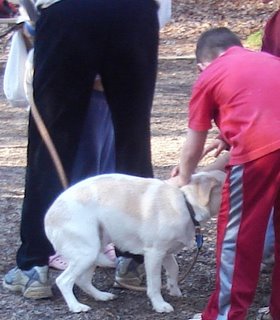 The park is a great place for kids to be free and let their energy out. Some dogs enjoy being around this type of activity while others do not. Recognizing your dog's signals and sensitivities can help you, your dog and others at the park have a successful visit.
The park is a great place for kids to be free and let their energy out. Some dogs enjoy being around this type of activity while others do not. Recognizing your dog's signals and sensitivities can help you, your dog and others at the park have a successful visit.Here are things to consider:
1. Does your dog greet new people with a relaxed wag and eager approach?
2. Does your dog listen and follow your directions?
3. Has your dog been around lots of active children before? (if not then introduce this type of situation with short successful visits and gradually extend the time and interaction....go slow!)
4. Will your children need your "hands on" supervision? If so how will you handle this?
Below is a situation that I commonly see. A Mom is tending to the immediate needs of a young child. Meanwhile......the dog and unfamiliar children are interacting despite the dog's indication of stress. Notice the tail tucked between the legs, observe the curving of the shoulder area as the dog is curling downward and away from the children. Nobody is helping or supporting this dog. Is this fair? Is this safe? As the Mother of four kids I understand this situation all too well. I too enjoy taking our dog/s places but often do not unless my husband is there to help supervise both kids and dog.
Here are some things to consider when deciding if your dog should tag along at the playground or if this may be a time for him to stay at home.If you are a parent of young toddlers or children who can not play independently then consider leaving your dog at home unless another adult joins you.
1. Is it a GORGROUS day and the park will be crowded?
2. Are your children independent enough that you will be able to supervise your dog as unfamiliar children approach and want to engage?
3. Are you comfortable declining offers to pet your dog if your dog is demonstrating stress? A good option in this situation is to say to a child or children that your dog would rather show off a trick instead of being pet right now. Have a plan.
4. What if another dog is there? How will your dog respond? Think about how many children will be approaching asking to pet your dog. If your dog does not get along with other dogs, this can put everyone in a bad spot.5. What if your child is hurt and needs your full attention? What is the plan then?
I encourage families to include their dogs in everyday activities as much as possible. Visits to the park, vacation trips and car rides are fun to share. It is essential that we set ourselves and our dogs up for success while enjoying these outings. We can not control the actions or responses of others. It is our responsibility to monitor and respond to the reactions and signals our dogs are offering while in these stimulating situations and engaging with many different children. To learn more about subtle body language and signals visit www.doggonesafe.com


No comments:
Post a Comment